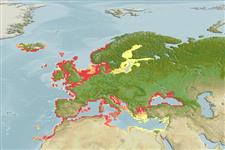Classification / Names
Common names from other countries
Issue
5 subspecies known.
Main reference
Size / Weight / Age
Max length : 60.0 cm SL male/unsexed; (Ref. 35388); common length : 40.0 cm SL male/unsexed; (Ref. 2945); max. published weight: 1.5 kg (Ref. 188); max. reported age: 25 years (Ref. 556)
Length at first maturity
Lm 32.5 range ? - ? cm
Environment
Marine; freshwater; brackish; pelagic-neritic; anadromous (Ref. 51243); depth range 10 - 300 m (Ref. 10541)
Climate / Range
Temperate, preferred 16°C (Ref. 107945); 70°N - 27°N, 25°W - 42°E
Distribution
Northeast Atlantic: southern Iceland, British Isles and southern Norway to Morocco, including the Baltic, Mediterranean and Black Seas (Refs. 188, 26334, 51442). Several subspecies have been recognized based on the number of gill rakers and geographical location (Ref. 10541) and some have since been given species-status (Ref. 59043).
Listed in Appendix III of the Bern Convention (2002).
Listed in Annex II and V of the EC Habitats Directive (2007).
Countries | FAO areas | Ecosystems | Occurrences | Introductions
Short description
Dorsal
spines
(total): 4 - 6;
Dorsal
soft rays
(total): 12-16;
Anal
spines: 3-4;
Anal
soft rays: 16 - 22;
Vertebrae: 49 - 59. Diagnosis: Body somewhat compressed, moderately deep with depth at pectoral fin less than head length, scutes apparent along belly (Ref. 188). Upper jaw notched, lower jaw fitting into it; no teeth on vomer; gillrakers fairly short and stout, total 30 to 80, longer than gill filaments (Ref. 188). A dark spot posterior to gill opening, followed by 7 or 8 similar spots along flank, but sometimes faint or absent (Ref. 188, 40476). Alosa fallax resembles Alosa alosa, which has more and longer gillrakers and at most only 3 dark spots on flank (Ref. 188).
IUCN Red List Status (Ref. 115185)
Threat to humans
Harmless
Human uses
Fisheries: minor commercial
More information
ReferencesAquacultureAquaculture profileStrainsGeneticsAllele frequenciesHeritabilityDiseasesProcessingMass conversion
Tools
Special reports
Download XML
Internet sources
Estimates of some properties based on models
Phylogenetic diversity index
PD50 = 0.5000 many relatives (e.g. carps) 0.5 - 2.0 few relatives (e.g. lungfishes)
Trophic Level
4.0 ±0.4 se; Based on diet studies.
Resilience
Medium, minimum population doubling time 1.4 - 4.4 years (K=0.21-0.38; tm=2-7; tmax=25; Fec>10,000)
Vulnerability
Moderate to high vulnerability (50 of 100)
Price category
